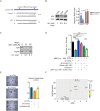STAT3-dependent long non-coding RNA Lncenc1 contributes to mouse ES cells pluripotency via stabilizing Klf4 mRNA
- PMID: 37801430
- PMCID: PMC11428181
- DOI: 10.1093/bfgp/elad045
STAT3-dependent long non-coding RNA Lncenc1 contributes to mouse ES cells pluripotency via stabilizing Klf4 mRNA
Erratum in
-
Correction to: STAT3-dependent long non-coding RNA Lncenc1 contributes to mouse ES cells pluripotency via stabilizing Klf4 mRNA.Brief Funct Genomics. 2024 Sep 27;23(5):682. doi: 10.1093/bfgp/elad047. Brief Funct Genomics. 2024. PMID: 37850822 Free PMC article. No abstract available.
-
Correction to: STAT3-dependent long non-coding RNA Lncenc1 contributes to mouse ES cells pluripotency via stabilizing Klf4 mRNA.Brief Funct Genomics. 2025 Jan 15;24:elaf012. doi: 10.1093/bfgp/elaf012. Brief Funct Genomics. 2025. PMID: 40662341 Free PMC article. No abstract available.
Abstract
Embryonic stem cells (ESCs) preserve the unique ability to differentiate into any somatic cell lineage while maintaining their self-renewal potential, relying on a complex interplay of extracellular signals regulating the expression/activity of pluripotency transcription factors and their targets. Leukemia inhibitory factor (LIF)-activated STAT3 drives ESCs' stemness by a number of mechanisms, including the transcriptional induction of pluripotency factors such as Klf4 and the maintenance of a stem-like epigenetic landscape. However, it is unknown if STAT3 directly controls stem-cell specific non-coding RNAs, crucial to balance pluripotency and differentiation. Applying a bioinformatic pipeline, here we identify Lncenc1 in mouse ESCs as an STAT3-dependent long non-coding RNA that supports pluripotency. Lncenc1 acts in the cytoplasm as a positive feedback regulator of the LIF-STAT3 axis by competing for the binding of microRNA-128 to the 3'UTR of the Klf4 core pluripotency factor mRNA, enhancing its expression. Our results unveil a novel non-coding RNA-based mechanism for LIF-STAT3-mediated pluripotency.
Keywords: Klf4; STAT3; lincRNAs; miR-128; microRNAs; naive pluripotency.
© The Author(s) 2023. Published by Oxford University Press.
Figures





References
MeSH terms
Substances
Grants and funding
LinkOut - more resources
Full Text Sources
Molecular Biology Databases
Miscellaneous

